SKODA OCTAVIA 2005 1.G / (1U) Owner's Manual
Manufacturer: SKODA, Model Year: 2005, Model line: OCTAVIA, Model: SKODA OCTAVIA 2005 1.G / (1U)Pages: 315, PDF Size: 11.8 MB
Page 131 of 315
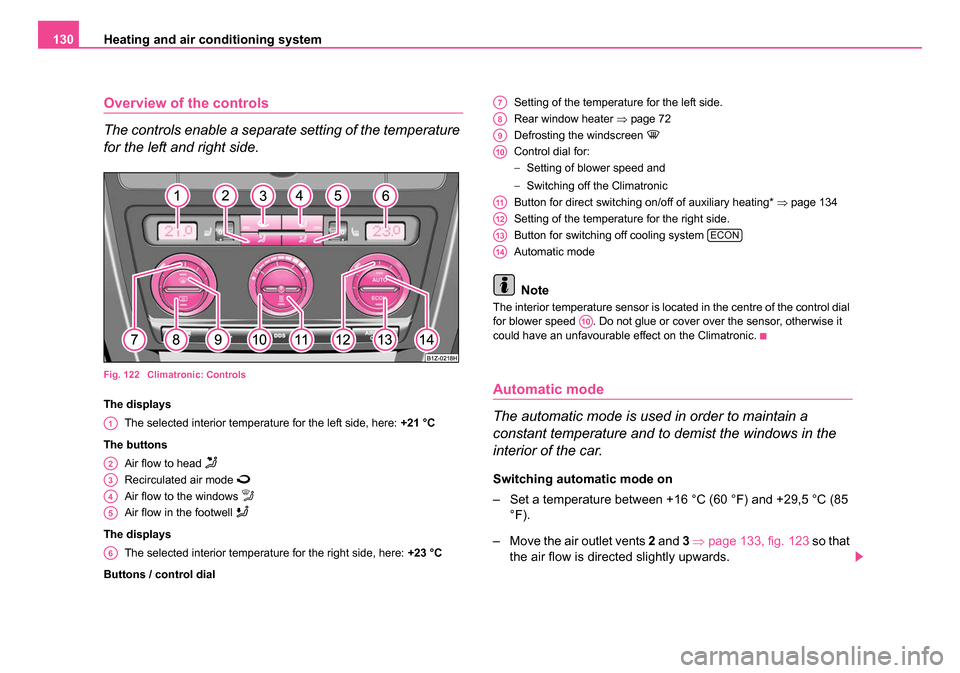
Heating and air conditioning system
130
Overview of the controls
The controls enable a separate setting of the temperature
for the left and right side.
Fig. 122 Climatronic: Controls
The displays
The selected interior temperature for the left side, here: +21 °C
The buttons Air flow to head
Recirculated air mode
Air flow to the windows
Air flow in the footwell
The displaysThe selected interior temperature for the right side, here: +23 °C
Buttons / control dial Setting of the temperature for the left side.
Rear window heater
⇒page 72
Defrosting the windscreen
Control dial for:
− Setting of blower speed and
− Switching off the Climatronic
Button for direct switching on/off of auxiliary heating* ⇒page 134
Setting of the temperature for the right side.
Button for switching off cooling system
Automatic mode
Note
The interior temperature sensor is located in the centre of the control dial
for blower speed . Do not glue or cover over the sensor, otherwise it
could have an unfavourable effect on the Climatronic.
Automatic mode
The automatic mode is used in order to maintain a
constant temperature and to demist the windows in the
interior of the car.
Switching automatic mode on
– Set a temperature between +16 °C (60 °F) and +29,5 °C (85 °F).
– Move the air outlet vents 2 and 3 ⇒ page 133, fig. 123 so that
the air flow is directed slightly upwards.
A1
A2
A3
A4
A5
A6
A7
A8
A9
A10
A11
A12
A13ECON
A14
A10
s24s.book Page 130 Thursday, November 24, 2005 12:27 PM
Page 132 of 315
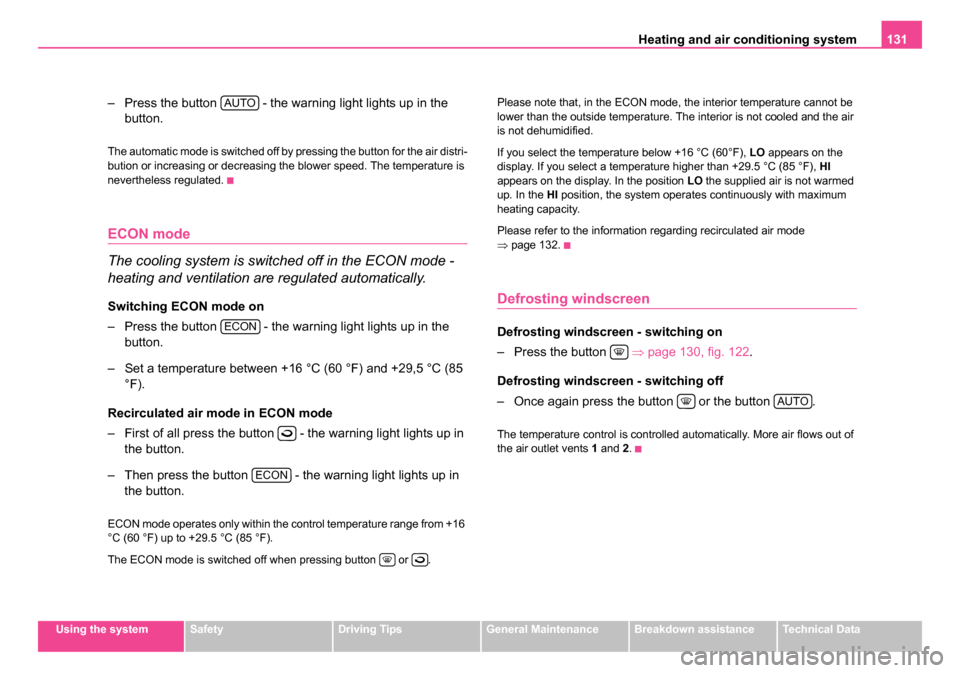
Heating and air conditioning system 131
Using the systemSafetyDriving TipsGeneral MaintenanceBreakdown assistanceTechnical Data
– Press the button - the warning light lights up in the
button.
The automatic mode is switched off by pressing the button for the air distri-
bution or increasing or decreasing the blower speed. The temperature is
nevertheless regulated.
ECON mode
The cooling system is switched off in the ECON mode -
heating and ventilation are regulated automatically.
Switching ECON mode on
– Press the button - the warning light lights up in the button.
– Set a temperature between +16 °C (60 °F) and +29,5 °C (85 °F).
Recirculated air mode in ECON mode
– First of all press the button - the warning light lights up in the button.
– Then press the button - the warning light lights up in the button.
ECON mode operates only within the control temperature range from +16
°C (60 °F) up to +29.5 °C (85 °F).
The ECON mode is switched off when pressing button or . Please note that, in the ECON mode, the interior temperature cannot be
lower than the outside temperature. The interior is not cooled and the air
is not dehumidified.
If you select the temperature below +16 °C (60°F),
LO appears on the
display. If you select a temperature higher than +29.5 °C (85 °F), HI
appears on the display. In the position LO the supplied air is not warmed
up. In the HI position, the system operates continuously with maximum
heating capacity.
Please refer to the information regarding recirculated air mode
⇒ page 132.
Defrosting windscreen
Defrosting windscreen - switching on
– Press the button ⇒page 130, fig. 122 .
Defrosting windscreen - switching off
– Once again press the button or the button .
The temperature control is controlled automatically. More air flows out of
the air outlet vents 1 and 2.
AUTO
ECON
ECON
AUTO
s24s.book Page 131 Thursday, November 24, 2005 12:27 PM
Page 133 of 315
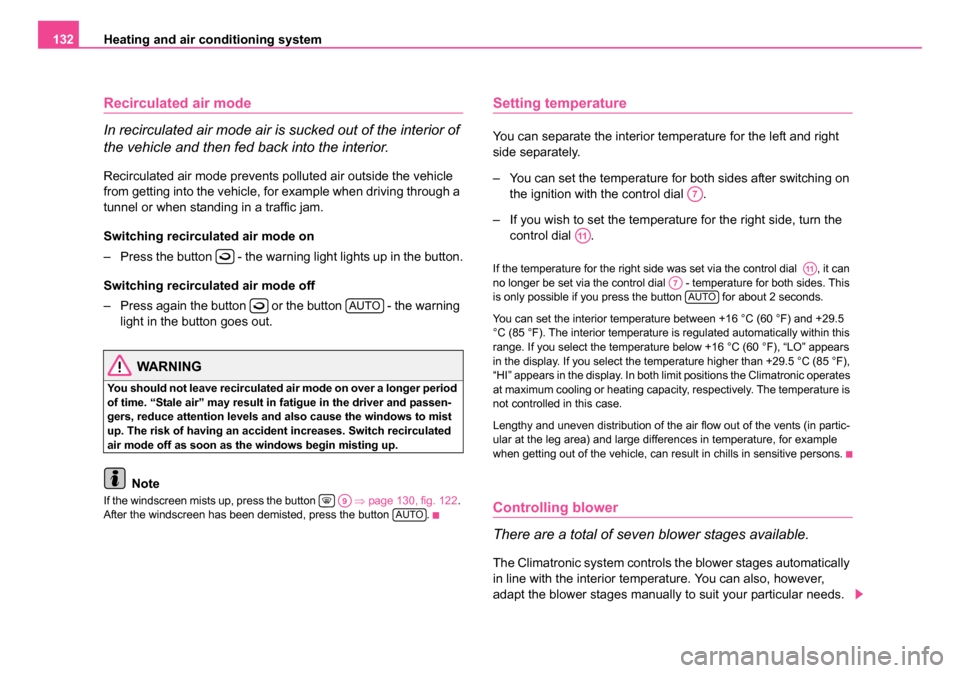
Heating and air conditioning system
132
Recirculated air mode
In recirculated air mode air is sucked out of the interior of
the vehicle and then fed back into the interior.
Recirculated air mode prevents polluted air outside the vehicle
from getting into the vehicle, for example when driving through a
tunnel or when standing in a traffic jam.
Switching recircul ated air mode on
– Press the button - the warning light lights up in the button.
Switching recirculat ed air mode off
– Press again the button or the button - the warning light in the button goes out.
WARNING
You should not leave recirculated air mode on over a longer period
of time. “Stale air” may result in fatigue in the driver and passen-
gers, reduce attention levels and also cause the windows to mist
up. The risk of having an accident increases. Switch recirculated
air mode off as soon as the windows begin misting up.
Note
If the windscreen mists up, press the button ⇒page 130, fig. 122 .
After the windscreen has been demisted, press the button .
Setting temperature
You can separate the interior temperature for the left and right
side separately.
– You can set the temperature for both sides after switching on the ignition with the control dial .
– If you wish to set the temperature for the right side, turn the control dial .
If the temperature for the right side was set via the control dial , it can
no longer be set via the control dial - temperature for both sides. This
is only possible if you press the button for about 2 seconds.
You can set the interior temperature between +16 °C (60 °F) and +29.5
°C (85 °F). The interior temperature is regulated automatically within this
range. If you select the temperature below +16 °C (60 °F), “LO” appears
in the display. If you select the temperature higher than +29.5 °C (85 °F),
“HI” appears in the display. In both limit positions the Climatronic operates
at maximum cooling or heating capacity, respectively. The temperature is
not controlled in this case.
Lengthy and uneven distribution of the air flow out of the vents (in partic-
ular at the leg area) and large differences in temperature, for example
when getting out of the vehicle, can result in chills in sensitive persons.
Controlling blower
There are a total of seven blower stages available.
The Climatronic system controls the blower stages automatically
in line with the interior temperature. You can also, however,
adapt the blower stages manually to suit your particular needs.
AUTO
A9AUTO
A7
A11
A11A7AUTO
s24s.book Page 132 Thursday, November 24, 2005 12:27 PM
Page 134 of 315
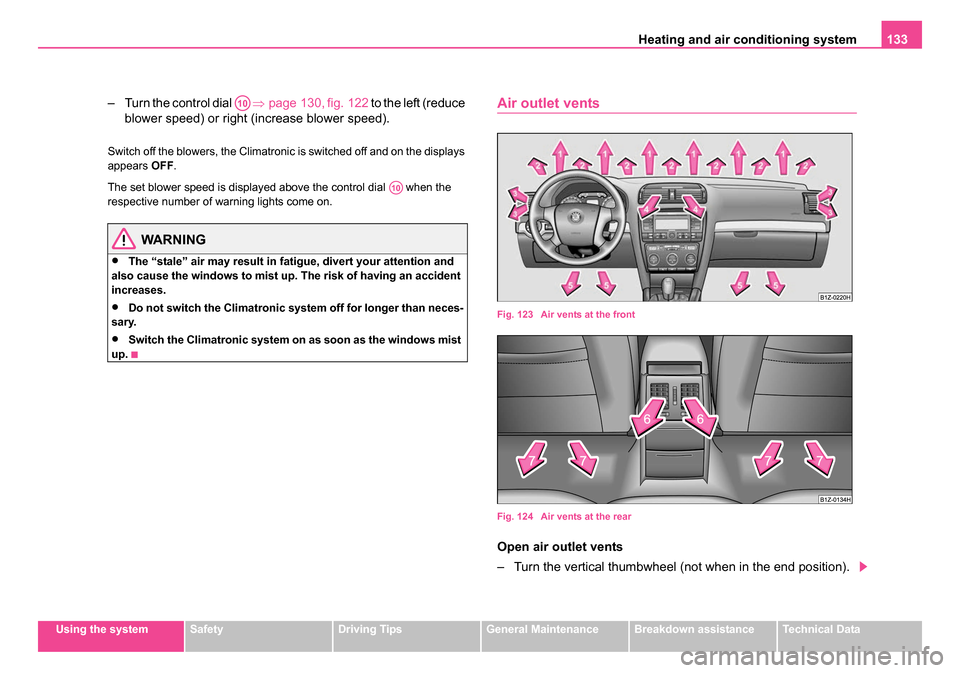
Heating and air conditioning system 133
Using the systemSafetyDriving TipsGeneral MaintenanceBreakdown assistanceTechnical Data
– Turn the control dial ⇒page 130, fig. 122 to the left (reduce
blower speed) or right (increase blower speed).
Switch off the blowers, the Climatronic is switched off and on the displays
appears OFF.
The set blower speed is displayed above the control dial when the
respective number of warning lights come on.
WARNING
•The “stale” air may result in fatigue, divert your attention and
also cause the windows to mist up. The risk of having an accident
increases.
•Do not switch the Climatronic system off for longer than neces-
sary.
•Switch the Climatronic system on as soon as the windows mist
up.
Air outlet vents
Fig. 123 Air vents at the front
Fig. 124 Air vents at the rear
Open air outlet vents
– Turn the vertical thumbwheel (not when in the end position).
A10
A10
s24s.book Page 133 Thursday, November 24, 2005 12:27 PM
Page 135 of 315
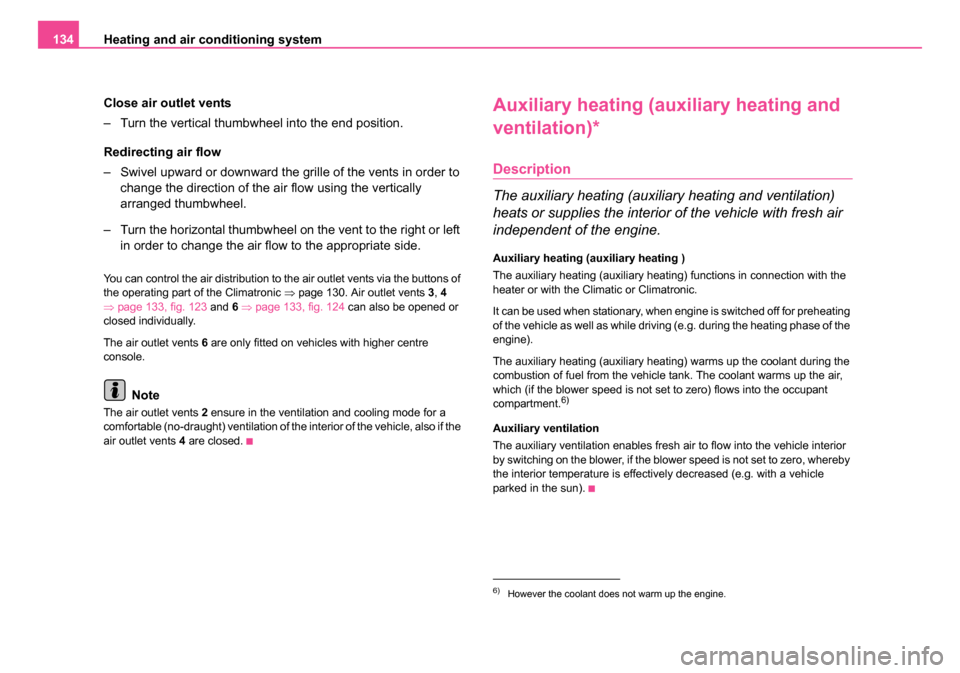
Heating and air conditioning system
134
Close air outlet vents
– Turn the vertical thumbwheel into the end position.
Redirecting air flow
– Swivel upward or downward the gril le of the vents in order to
change the direction of the air flow using the vertically
arranged thumbwheel.
– Turn the horizontal thumbwheel on the vent to the right or left in order to change the air flow to the appropriate side.
You can control the air distribution to the air outlet vents via the buttons of
the operating part of the Climatronic ⇒page 130. Air outlet vents 3, 4
⇒ page 133, fig. 123 and 6 ⇒ page 133, fig. 124 can also be opened or
closed individually.
The air outlet vents 6 are only fitted on vehicles with higher centre
console.
Note
The air outlet vents 2 ensure in the ventilation and cooling mode for a
comfortable (no-draught) ventilation of the interior of the vehicle, also if the
air outlet vents 4 are closed.
Auxiliary heating (auxiliary heating and
ventilation)*
Description
The auxiliary heating (auxiliary heating and ventilation)
heats or supplies the interior of the vehicle with fresh air
independent of the engine.
Auxiliary heating (auxiliary heating )
The auxiliary heating (auxiliary heating) functions in connection with the
heater or with the Climatic or Climatronic.
It can be used when stationary, when engine is switched off for preheating
of the vehicle as well as while driving (e.g. during the heating phase of the
engine).
The auxiliary heating (auxiliary heating) warms up the coolant during the
combustion of fuel from the vehicle tank. The coolant warms up the air,
which (if the blower speed is not set to zero) flows into the occupant
compartment.
6)
Auxiliary ventilation
The auxiliary ventilation enables fresh air to flow into the vehicle interior
by switching on the blower, if the blower speed is not set to zero, whereby
the interior temperature is effectively decreased (e.g. with a vehicle
parked in the sun).
6)However the coolant does not warm up the engine.
s24s.book Page 134 Thursday, November 24, 2005 12:27 PM
Page 136 of 315
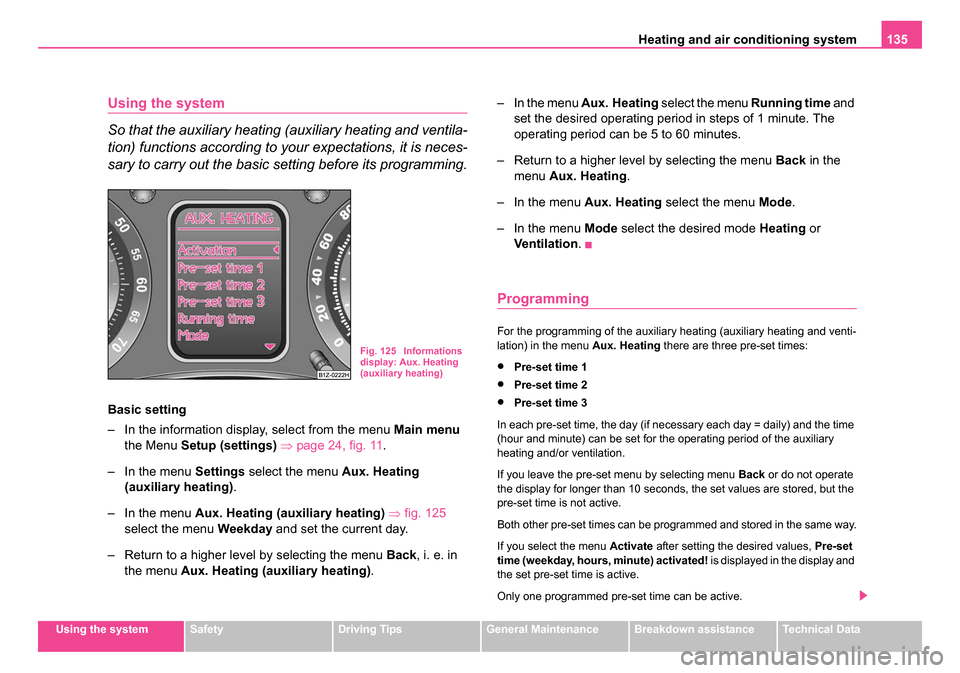
Heating and air conditioning system 135
Using the systemSafetyDriving TipsGeneral MaintenanceBreakdown assistanceTechnical Data
Using the system
So that the auxiliary heating (auxiliary heating and ventila-
tion) functions according to your expectations, it is neces-
sary to carry out the basic setting before its programming.
Basic setting
– In the information display, select from the menu Main menu
the Menu Setup (settings) ⇒ page 24, fig. 11 .
– In the menu Settings select the menu Aux. Heating
(auxiliary heating) .
– In the menu Aux. Heating (auxiliary heating) ⇒ fig. 125
select the menu Weekday and set the current day.
– Return to a higher level by selecting the menu Back, i. e. in the menu Aux. Heating (auxiliary heating) .– In the menu Aux. Heating
select the menu Running time and
set the desired operating period in steps of 1 minute. The
operating period can be 5 to 60 minutes.
– Return to a higher level by selecting the menu Back in the
menu Aux. Heating.
– In the menu Aux. Heating select the menu Mode.
– In the menu Mode select the desired mode Heating or
Ventilation .
Programming
For the programming of the auxiliary heating (auxiliary heating and venti-
lation) in the menu Aux. Heating there are three pre-set times:
•Pre-set time 1
•Pre-set time 2
•Pre-set time 3
In each pre-set time, the day (if necessary each day = daily) and the time
(hour and minute) can be set for the operating period of the auxiliary
heating and/or ventilation.
If you leave the pre-set menu by selecting menu Back or do not operate
the display for longer than 10 seconds, the set values are stored, but the
pre-set time is not active.
Both other pre-set times can be programmed and stored in the same way.
If you select the menu Activate after setting the desired values, Pre-set
time (weekday, hours, minute) activated! is displayed in the display and
the set pre-set time is active.
Only one programmed pre-set time can be active.
Fig. 125 Informations
display: Aux. Heating
(auxiliary heating)
s24s.book Page 135 Thursday, November 24, 2005 12:27 PM
Page 137 of 315
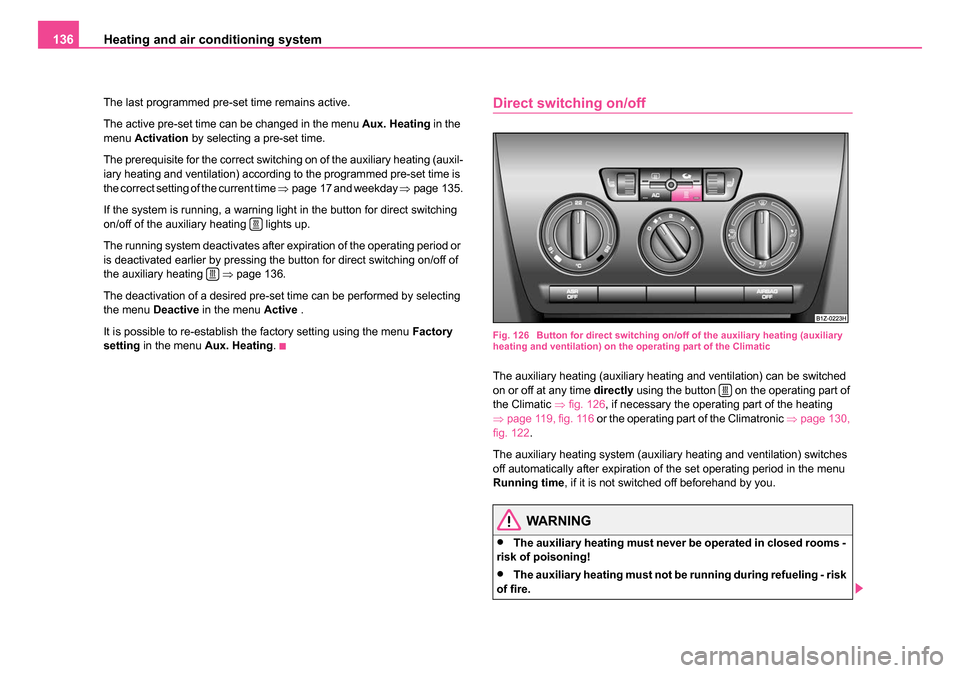
Heating and air conditioning system
136
The last programmed pre-set time remains active.
The active pre-set time can be changed in the menu Aux. Heating in the
menu Activation by selecting a pre-set time.
The prerequisite for the correct switching on of the auxiliary heating (auxil-
iary heating and ventilation) according to the programmed pre-set time is
the correct setting of the current time ⇒page 17 and weekday ⇒ page 135.
If the system is running, a warning light in the button for direct switching
on/off of the auxiliary heating lights up.
The running system deactivates after expiration of the operating period or
is deactivated earlier by pressing the button for direct switching on/off of
the auxiliary heating ⇒page 136.
The deactivation of a desired pre-set time can be performed by selecting
the menu Deactive in the menu Active .
It is possible to re-establish the factory setting using the menu Factory
setting in the menu Aux. Heating .Direct switching on/off
Fig. 126 Button for direct switching on/off of the auxiliary heating (auxiliary
heating and ventilation) on the operating part of the Climatic
The auxiliary heating (auxiliary heating and ventilation) can be switched
on or off at any time directly using the button on the operating part of
the Climatic ⇒fig. 126 , if necessary the operating part of the heating
⇒ page 119, fig. 116 or the operating part of the Climatronic ⇒page 130,
fig. 122 .
The auxiliary heating system (auxiliary heating and ventilation) switches
off automatically after expiration of the set operating period in the menu
Running time , if it is not switched off beforehand by you.
WARNING
•The auxiliary heating must never be operated in closed rooms -
risk of poisoning!
•The auxiliary heating must not be running during refueling - risk
of fire.
s24s.book Page 136 Thursday, November 24, 2005 12:27 PM
Page 138 of 315
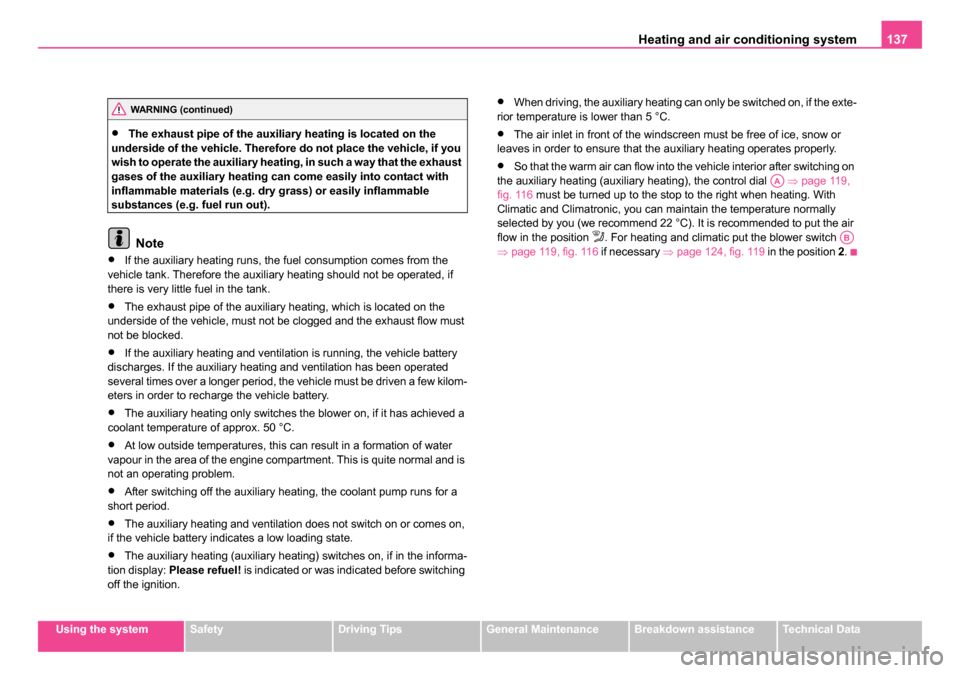
Heating and air conditioning system 137
Using the systemSafetyDriving TipsGeneral MaintenanceBreakdown assistanceTechnical Data
•The exhaust pipe of the auxiliary heating is located on the
underside of the vehicle. Therefore do not place the vehicle, if you
wish to operate the auxiliary heating, in such a way that the exhaust
gases of the auxiliary heating can come easily into contact with
inflammable materials (e.g. dry grass) or easily inflammable
substances (e.g. fuel run out).
Note
•If the auxiliary heating runs, the fuel consumption comes from the
vehicle tank. Therefore the auxiliary heating should not be operated, if
there is very little fuel in the tank.
•The exhaust pipe of the auxiliary heating, which is located on the
underside of the vehicle, must not be clogged and the exhaust flow must
not be blocked.
•If the auxiliary heating and ventilation is running, the vehicle battery
discharges. If the auxiliary heating and ventilation has been operated
several times over a longer period, the vehicle must be driven a few kilom-
eters in order to recharge the vehicle battery.
•The auxiliary heating only switches the blower on, if it has achieved a
coolant temperature of approx. 50 °C.
•At low outside temperatures, this can result in a formation of water
vapour in the area of the engine compartment. This is quite normal and is
not an operating problem.
•After switching off the auxiliary heating, the coolant pump runs for a
short period.
•The auxiliary heating and ventilation does not switch on or comes on,
if the vehicle battery indicates a low loading state.
•The auxiliary heating (auxiliary heating) switches on, if in the informa-
tion display: Please refuel! is indicated or was indicated before switching
off the ignition.
•When driving, the auxiliary heating can only be switched on, if the exte-
rior temperature is lower than 5 °C.
•The air inlet in front of the windscreen must be free of ice, snow or
leaves in order to ensure that the auxiliary heating operates properly.
•So that the warm air can flow into the vehicle interior after switching on
the auxiliary heating (auxiliary heating), the control dial ⇒page 119,
fig. 116 must be turned up to the stop to the right when heating. With
Climatic and Climatronic, you can maintain the temperature normally
selected by you (we recommend 22 °C). It is recommended to put the air
flow in the position
. For heating and climatic put the blower switch
⇒ page 119, fig. 116 if necessary ⇒page 124, fig. 119 in the position 2.
WARNING (continued)
AA
AB
s24s.book Page 137 Thursday, November 24, 2005 12:27 PM
Page 139 of 315
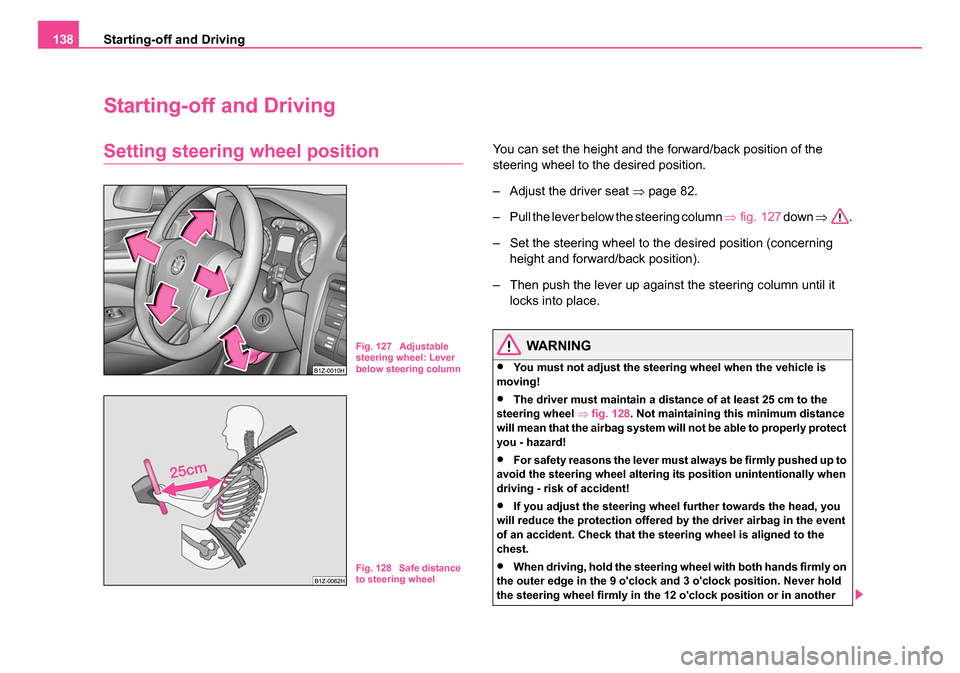
Starting-off and Driving
138
Starting-off and Driving
Setting steering wheel positionYou can set the height and the forward/back position of the
steering wheel to the desired position.
– Adjust the driver seat ⇒page 82.
– Pull the lever below the steering column ⇒fig. 127 down ⇒.
– Set the steering wheel to the desired position (concerning height and forward/back position).
– Then push the lever up against the steering column until it locks into place.
WARNING
•You must not adjust the steering wheel when the vehicle is
moving!
•The driver must maintain a distance of at least 25 cm to the
steering wheel ⇒fig. 128 . Not maintaining this minimum distance
will mean that the airbag system will not be able to properly protect
you - hazard!
•For safety reasons the lever must always be firmly pushed up to
avoid the steering wheel altering its position unintentionally when
driving - risk of accident!
•If you adjust the steering wheel further towards the head, you
will reduce the protection offered by the driver airbag in the event
of an accident. Check that the steering wheel is aligned to the
chest.
•When driving, hold the steering wheel with both hands firmly on
the outer edge in the 9 o'clock and 3 o'clock position. Never hold
the steering wheel firmly in the 12 o'clock position or in another
Fig. 127 Adjustable
steering wheel: Lever
below steering column
Fig. 128 Safe distance
to steering wheel
s24s.book Page 138 Thursday, November 24, 2005 12:27 PM
Page 140 of 315
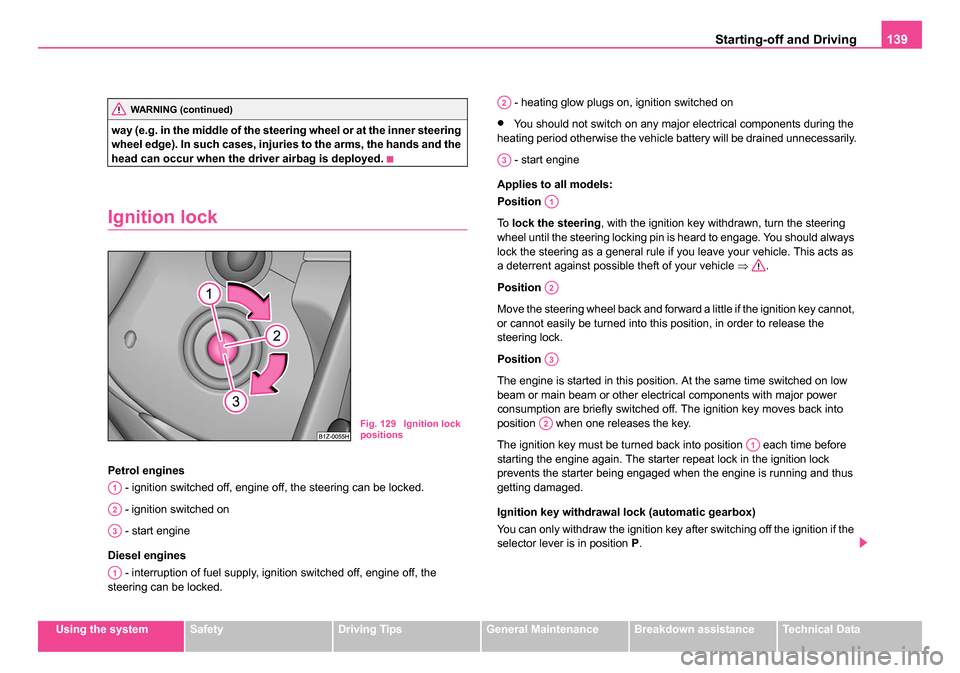
Starting-off and Driving139
Using the systemSafetyDriving TipsGeneral MaintenanceBreakdown assistanceTechnical Data
way (e.g. in the middle of the steering wheel or at the inner steering
wheel edge). In such cases, injuries to the arms, the hands and the
head can occur when the driver airbag is deployed.
Ignition lock
Petrol engines
- ignition switched off, engine off, the steering can be locked.
- ignition switched on
- start engine
Diesel engines - interruption of fuel supply, ignition switched off, engine off, the
steering can be locked. - heating glow plugs on, ignition switched on
•You should not switch on any major electrical components during the
heating period otherwise the vehicle battery will be drained unnecessarily.
- start engine
Applies to all models:
Position
To lock the steering , with the ignition key withdrawn, turn the steering
wheel until the steering locking pin is heard to engage. You should always
lock the steering as a general rule if you leave your vehicle. This acts as
a deterrent against possible theft of your vehicle ⇒.
Position
Move the steering wheel back and forward a little if the ignition key cannot,
or cannot easily be turned into this position, in order to release the
steering lock.
Position
The engine is started in this position. At the same time switched on low
beam or main beam or other electrical components with major power
consumption are briefly switched off. The ignition key moves back into
position when one releases the key.
The ignition key must be turned back into position each time before
starting the engine again. The starter repeat lock in the ignition lock
prevents the starter being engaged when the engine is running and thus
getting damaged.
Ignition key withdrawal lock (automatic gearbox)
You can only withdraw the ignition key after switching off the ignition if the
selector lever is in position P.
WARNING (continued)
Fig. 129 Ignition lock
positions
A1
A2
A3
A1
A2
A3
A1
A2
A3
A2
A1
s24s.book Page 139 Thursday, November 24, 2005 12:27 PM